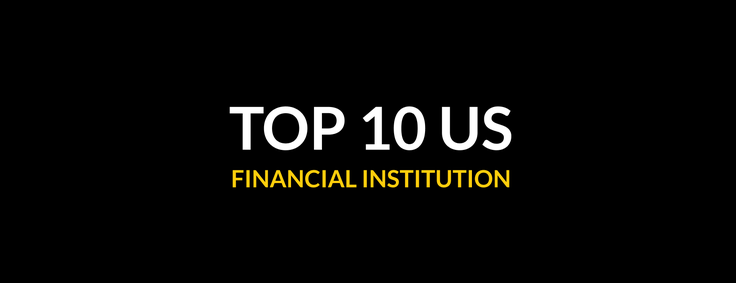
Wealth management is an intensely competitive offering for banks and other financial services institutions. It requires high concurrency – the ability to serve many users, fast – low latency, and the ability to access vast amounts of current and historical data in real time. Institutions have used in-memory databases and streaming data to try to meet the demand. In this webinar, SingleStore’s Sourabh Mehta shows how SingleStore improves the wealth management experience for users and gives institutions the ability to stand out in this competitive area. You can view the wealth management webinar here.
In the webinar, Sourabh describes the “before” and “after” architecture for a bank that provides wealth management dashboards to clients, whether individuals or family offices. By replacing a Hadoop/HDFS data store with SingleStore, the bank was able to deliver much more responsive updates to users, with query responsiveness in the tens of milliseconds; support tens of thousands of simultaneous users, and add more users without additional engineering work or expense; analyze five times as much historical data to provide better answers to user queries; and to avoid the processing and responsiveness delays that had previously occurred when important market news hit and usage surged.
This webinar was originally presented as part of our webinar series, How Data Innovation is Transforming Banking (click the link to access the entire series of webinars and slides). This series includes several webinars, described in these three blog posts:
- Real-Time Fraud Detection for an Improved Customer Experience
- Providing Better Wealth Management with Real-Time Data (this webinar)
- Modernizing Portfolio Analytics for Reduced Risk and Better Performance
Also included are these two case studies:
- Replacing Exadata with SingleStore to Power Portfolio Analytics
- Machine Learning and Fraud Detection “On the Swipe” For Major US Bank
You can also read about SingleStore’s work in financial services – including use cases and reference architectures that are applicable across industries – in SingleStore’s Financial Services Solutions Guide. If you’d like to request a printed and bound copy, contact SingleStore.
The Importance of Digital Transformation and Wealth Management
According to a Gartner survey, digital transformation is the top priority for banks, with almost double the interest of any other priority. It’s also a factor in all the other priorities they describe – revenue and business growth, operational excellence, customer experience, cost optimization and reduction, and data and analytics.
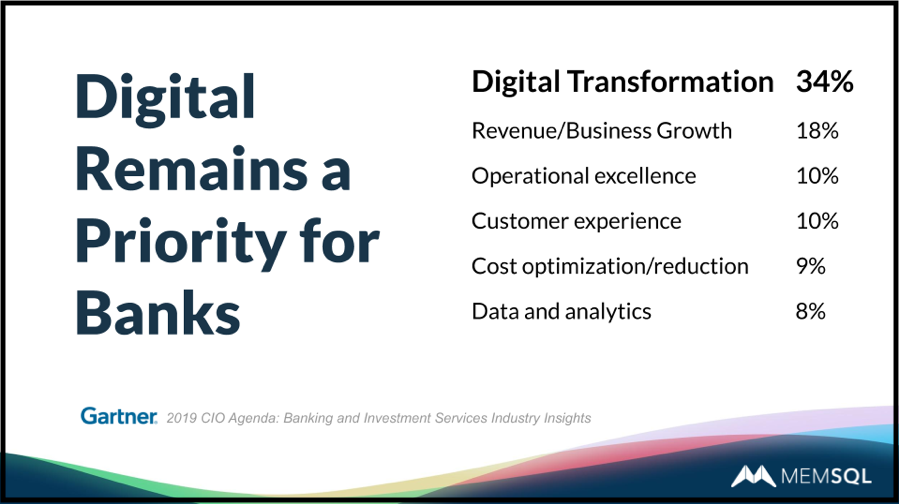
Wealth management is a critical business area for banks, and a top target for digital transformation:
- Deloitte says that 80% of retail bank profits are generated by high net worth individuals.
- Aite says that US brokerages and registered investment advisers manage a total of \$24.2 trillion in assets – a few trillion dollars more than the size of the US economy.
- Assets controlled by these individuals are expected to rise by 25% in the current five-year period to 2021.
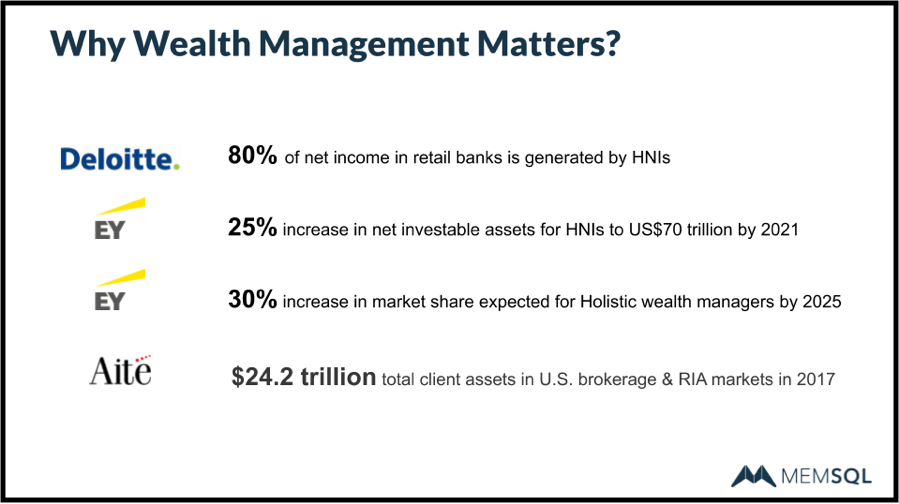
So wealth management is large, fast-growing, and strategic – perhaps the #1 strategic focus, in many cases – for banks and other financial institutions. Digital transformation of wealth management offerings is a top priority.
New Data Initiatives for Banks
Speeding up the delivery of data to the wealth management dashboard allows the user to get the information they need to make decisions without any visible delay; “we don’t want them to see a spinning wheel,” is how banks often describe the desired experience.

What banks want to eliminate, for their users, is called “event to insight latency” – that is, the waiting time between a request for information, or new information arriving from data sources, and the appearance of the information onscreen. This allows the user to interact smoothly with financial information, take action, see the response, and move on.
In order to deliver a positive experience for customers, companies set up service level agreements (SLAs) across their digital delivery infrastructure. Meeting these SLAs is crucial, but difficult to manage as the number of users increases, the complexity of queries increases at the same time, and with news events that affect financial markets driving sudden surges in usage.
Case Study – Wealth Management Dashboards
A large US bank was struggling with their wealth management solution. Based on a Hadoop/HDFS solution, the solution had many problems, but the worst was batch data loading. Data didn’t stream into the solution; instead, it was pooled for an hour, then a batch upload was run. (Batch uploads are the default for Hadoop/HDFS.) During the batch uploads, queries were locked out, which users found unacceptable.
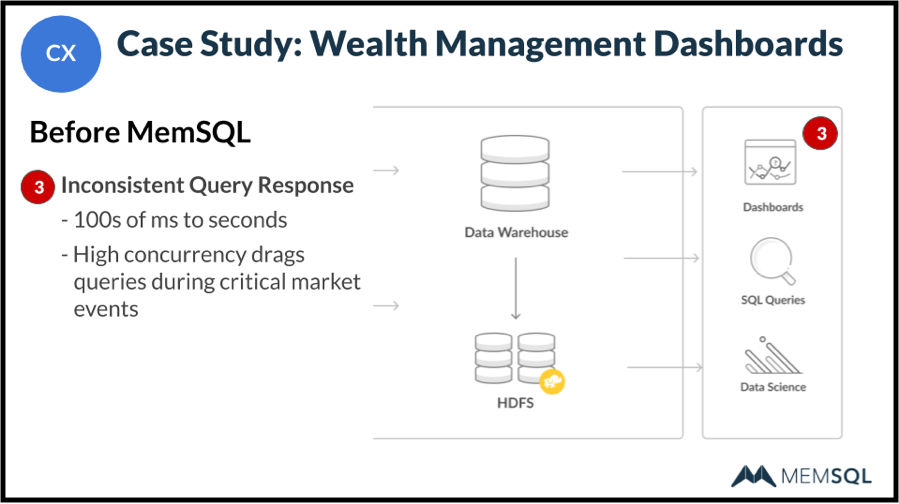
In addition, queries were slow, ranging from tenths of a second into seconds. And concurrency support was poor; when critical market events occurred, and users moved onto the system en masse, response times slowed to a crawl.
The SingleStore Solution
The bank augmented the Hadoop/HDFS database with SingleStore, using SingleStore to power the wealth management solution and leaving Hadoop/HDFS as a data lake for long-term data storage. The results have been excellent:
- Data is streamed into SingleStore in real-time; no waiting for data to be batched.
- Ingest and query processing run lock-free, simultaneously; no query downtime during batch updates.
- Five years’ history instead of one; applications and user-driven queries can draw on five times as much data at hand for deeper analysis.
- Fast responsiveness; queries are answered in 10s of milliseconds, with no spinning wheel.
- High concurrency; 40,000 users are supported with no contention, even when market events cause spikes in usage.
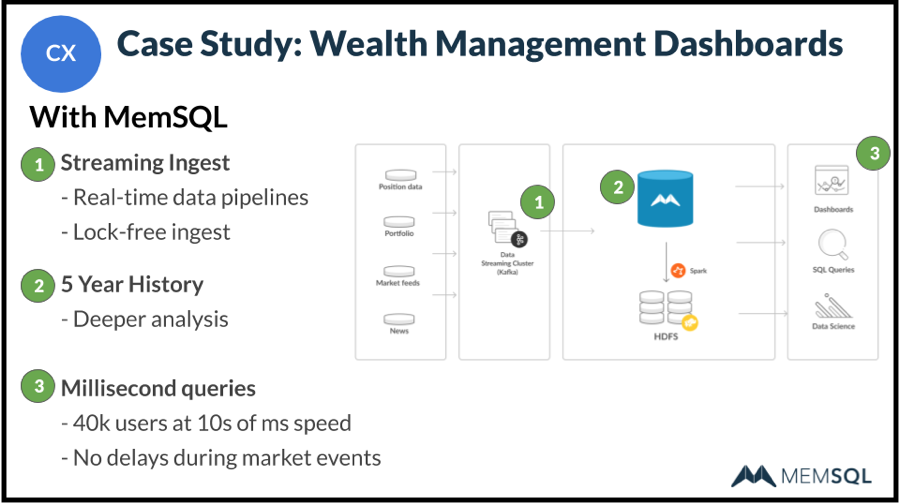
Conclusion
SingleStore is great for augmenting Hadoop/HDFS and other existing systems that suffer from slow responsiveness, batch update timeouts, and concurrency issues. You can view the wealth management webinar, download and run SingleStore for free, or contact SingleStore today.





